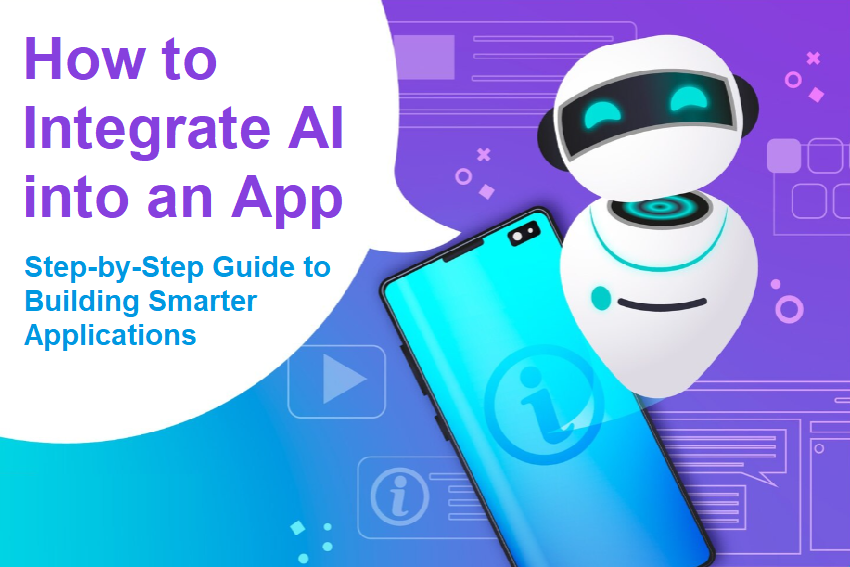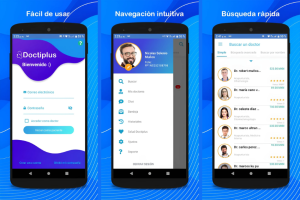The digital era experiences revolutionary transformations in app functionality through artificial intelligence (AI) which enables smarter application performance with personalized interactions at a faster speed. The path to integrate AI into an app becomes unmanageable for numerous developers alongside businesses when there is no distinct guideline.
But that’s a far bigger question: How do you integrate AI into an app to achieve results that really make a difference in your app? We walk through this in detail and offer best practices as well as provide some real-world examples of how you can successfully apply AI for distinction.
This step-by-step guide is created to explain how to integrate AI into your app. For both professional developers and business owners who want to improve their app features this guide provides fundamental steps from selecting proper AI tools and platforms through efficient machine learning model implementation. Our guide will lead you to a full grasp of using AI to improve your application’s performance. Let’s dive in!
Understanding the Role of AI in Your App
Before jumping into the technical details to integrate AI into an App, it is fundamentally important to define its purpose within your app. AI isn’t an add-on to make something “more interesting”; it needs to solve real problems, improve a user experience, or offer a path to operational efficiency.
Key Considerations for AI’s Role
What challenges does your app face?
Whether it’s improving personalization, speeding up processes, or handling vast data sets, AI can solve these problems with greater efficiency.
What kind of data do you have?
AI feeds on data. Developing successful AI features requires high-quality, structured data.
What outcomes do you want to achieve?
Be it better engagement, higher ROI, or smarter automation, knowing what you want to achieve helps determine the right AI solution.
AI’s Common Applications in Apps
Here’s where AI fits into real-world applications:
- Personalized Experiences: AI-based recommendation engines in apps like Netflix or Amazon tailor content to individual users.
- Customer Support: AI Chatbots are allowing for quick and easy engagement with consumers.
- Automation: Apps that can auto-scan your invoices or manage the workflow can be of great help.
- Predictive Analytics: AI will be able to predict future behaviors by studying historical behavior, both for organizations and users.
Examples of AI Applications
1. AI in E-Commerce Apps
E-commerce platforms leverage AI to create tailored shopping experiences, build trust, and optimize operations:
Personalized Recommendations:
Amazon and eBay use complex AI algorithms to evaluate user activity, such as search history, purchases, and even time spent on specific product pages. This data powers recommendation systems, suggesting that users are more likely to buy products. You must have come across a line that pops up when you open Amazon that is “Customers who bought this also bought”, which is another example of AI being aggressively used in sales and marketing.
AI-Powered Chatbots:
AI chatbots are also actively integrated with Shopify and other e-commerce platforms where they provide human-like experiences to users while interacting with them on issues like “how to track my order” and “how to process my refund.” These bots operate at any given time of day and help cut the time and money involved in the provision of customer service. According to the analysis of market growth, by 2025, the chatbot market will hit $3.68 billion, proving its necessity as an entity.
Fraud Detection:
To identify fraud, AI systems look for odd transaction patterns, such as mismatched billing addresses or a high volume of purchases. To safeguard both buyers and sellers, PayPal uses AI to analyze millions of transactions every day.
2. AI in Healthcare Apps
AI is revolutionizing healthcare by making it more accessible, accurate, and proactive:
Symptom Checkers:
Ada is an app that lets patients enter symptoms and uses AI to identify potential health issues and recommendations for action. These are based on extensive medical databases to ensure accuracy and relevance and to act as a first line of diagnosis.
Monitoring Patients Remotely:
Other wearables with built-in applications, like the Apple Watch or Fitbit, will evaluate health parameters like oxygen saturation, heart rate, and sleep patterns using AI algorithms. For instance, AliveCor uses AI to scan for irregular rhythms in the heartbeat and alert its user for a consultation, thus preventing such life-threatening conditions.
Medical Image Analysis:
AI in healthcare apps can help diagnose anomalies such as tumors or fractures from X-rays, MRIs, and CT scans more quickly and with high accuracy. Apps like Qure.ai are now making such AI-based analysis available even to the smallest clinics.
3. AI in Entertainment and Media Apps
AI is changing how people consume media. AI offers curated content and seamless user experiences:
Content Recommendations:
For example, Netflix makes its recommendations for the shows and movies users watch, based on users’ viewing histories, ratings, and patterns of watch history. These recommendations have resulted in very interactive and retaining systems through its feedback-evolved AI system.
Voice and Image Recognition:
Media apps such as YouTube use AI to make it easier to navigate with voice-based search and content recognition. For instance, users can say, “Show me videos about AI,” and receive instant results without typing.
Content Creation:
AI tools like Runway ML are helping content creators design graphics, videos, and animations within entertainment apps, drastically cutting down production time.
4. AI in Finance and Banking Apps
The finance industry relies heavily on AI for security, personalization, and financial planning:
Budgeting and Expense Tracking:
YNAB and Mint are the two apps that use artificial intelligence to group user spending into distinct categories like food, utilities, and entertainment. These apps help users manage their budgets effectively with the insights they offer. Additionally, AI learns over time and modifies categories according to user purchasing patterns.
Fraud Prevention:
AI in applications such as Revolut recognizes and analyzes the spending behavior of users for any unclassified patterns and variances that may indicate fraud. For example, upon detecting the suspicious nature of a transaction, AI can immediately block the card and notify the user, therefore saving precious time.
Robo-Advisors:
Personalized investment advice is available from AI-based financial advisors found in apps such as Betterment or Wealthfront. These apps base recommendations on a user’s goals, risk tolerance, and trends in the markets, thereby obviating expensive human advisors.
5. AI in Productivity and Business Apps
Productivity apps use AI to help people save time, organize work better, and do it smarter.
Task Management and Prioritization:
Apps such as Trello and Asana use AI to scan deadlines, distribution of workload, and dependencies between projects in order to enlighten users so that they prioritize tasks accordingly to enhance teamwork.
Smart Document Scanning and Organization:
Tools like CamScanner and Adobe Scan make use of AI for OCR conversion to editable text for scanned documents. Automatically categorizing files makes document retrieval easy.
Meeting Summaries and Transcriptions:
To save hours of taking notes manually, apps like Otter.ai use artificial intelligence (AI) to transcribe live meetings and even summarize important topics.
Step-by-Step Guide to Integrate AI into an App

Integrate AI into an app can be a transformative process, but it requires careful planning and execution. Here are the detailed steps to ensure a seamless and successful integration.
1. Identify Needs and Define Goals
Before jumping into AI implementation, clearly identify the problem you want to solve and the value AI will bring to your app.
Understand Your Audience: Analyze your users. Is it an engagement boost, simplifying a process, or perhaps improving user experience? For example, an e-commerce app would want to offer personalized recommendations while the health care app perhaps requires faster diagnostics i.e. response time.
Set Specific Goals: Break down your objectives into measurable outcomes. For example:
- You can make 15% more users stay on your site by recommending personalized content.
- Features such as an AI chatbot can reduce manual intervention in customer service by 40%.
2. Choose the Right Technology and Tools
The next step would be to identify suitable AI technologies, frameworks, and tools based on your application’s needs.
AI Frameworks and Libraries: Depending on your application, you can use the following well-known frameworks:
- TensorFlow: Ideal for building deep learning models.
- PyTorch: Excellent for research and production-level AI systems.
- scikit-learn: Useful for simpler machine learning models.
Third-Party AI APIs: If you don’t want to build the AI models, you can use the third-party APIs.
- Google Cloud AI: Offers vision AI and natural language processing (NLP).
- OpenAI: Provides pre-built models for AI chatbots and text generation.
- Amazon Web Services (AWS) AI: Features tools for recommendation engines and fraud detection.
Scalability Considerations: Choose tools that can grow with your app. Make sure the platform supports cloud deployment to handle growing user demands efficiently.
3. Collect and Prepare Data
AI models thrive on high-quality data. This is one of the most important steps to integrate AI into an app to be accurate and reliable.
Data Collection: Collect relevant data from internal sources (e.g., user behavior logs, and transaction records) or external databases. For example:
- E-commerce apps: Collect purchase history, browsing patterns, and cart abandonment rates.
- Finance apps: Gather financial transactions, spending patterns, and user profiles.
Data Cleaning: For accuracy, you need to eliminate any redundant information, inconsistent data, and unnecessary data. An AI project’s success depends on data preparation, which might consume up to 80% of your time.
Labeling Data: If your AI model requires a supervised learning system, ensure that you have datasets labeled. A chatbot is an example, which requires conversational data to be labeled for effective learning.
Secure Data Handling: Address data security concerns, as 75% of users worry about AI and data privacy. Use encryption, anonymization, and strict access controls.
4. Develop and Train AI Models
The next step is to create and train the AI models that will drive your app once your data is ready.
Model Selection: Choose a model that matches your goal:
- Natural Language Processing (NLP): It is used to create chatbots, voice assistants, and text analysis.
- Computer Vision: Detects faces, identifies objects, and processes images.
- Predictive Analytics: It is used to predict sales, detect fraud, predict user behavior, and so on.
Model Training: Use your prepared data to train the model so it can start picking up on the patterns that emerge and will use them in predictions. Just be sure that you split up the data into three folds:
- Training Data: Used to teach the model.
- Validation Data: Used to fine-tune the model.
- Testing Data: Ensures that the model works correctly on unseen data.
Iterative Improvement: Training AI is not a one-time process. You may need to tweak parameters, test different algorithms, and refine your model repeatedly for optimal results.
5. Integrate AI Models into Your App
After the model is developed, it must be seamlessly integrated into your app’s architecture.
- API Integration: Now deploy your trained AI model as a RESTful API, and it will be accessible to your app. For example, a chatbot API can be integrated into a messaging platform with minimal changes.
- Real-Time Processing: Make sure the AI model is installed on servers with low latency if your app requires real-time predictions. Instead of depending on cloud servers, technologies like Edge AI can assist you by processing data locally.
- UI Integration: The AI component should blend naturally with your app’s interface. For instance, if you’re adding a voice assistant, its activation should feel intuitive and seamless for users.
6. Test and Optimize
To make sure that the AI performs as anticipated in practical situations, testing your app is essential.
- Functional Testing: Validate that the AI model performs its intended task. For example, check whether a recommendation engine suggests relevant products.
- Performance Testing: Test for scalability, speed, and resource utilization. An AI model that slows down the app or crashes under heavy load is sure to frustrate the users.
- User Feedback: Release the AI feature to a small group of beta users and gather feedback. Pay attention to any frustrations or concerns users might have, especially around accuracy and ease of use.
- Optimization: Refine the AI model based on feedback and testing. For example, if a chatbot provides irrelevant responses, revisit the training data or adjust the NLP model.
7. Monitor and Maintain
Integrating AI into an app doesn’t just end with deployment; it requires ongoing monitoring to remain effective.
- Track Performance Metrics: Use analytics tools to monitor the key performance indicators (KPIs) like response times, prediction accuracy, user engagement rates, etc.
- Update Models Regularly: Over time, the data patterns your AI was trained on may change. For example, an e-commerce app has changing user preferences, and it needs to adapt to them. Periodically retrain models with fresh data.
- Verify Compliance: Stay updated on regulations like GDPR or CCPA to maintain compliance with data privacy regulations as applicable to your app.
- Monitor Security: Protect your AI models from cyberattacks through the deployment of secure APIs and strong authentication mechanisms.
Best Practices to Integrate AI into an App
If you want to integrate AI into an app, you require both, technical expertise and adherence to proven practices that improve the effectiveness, reliability, and user experience of your application.
1. Start Small and Scale Gradually
AI projects can be complicated and resource-intensive. It is best to start with one specific use case like personalized recommendations or predictive text, to test how deep the water is. This allows you to refine your AI model based on early feedback. Piloting with a small user group helps identify issues before full deployment, ensuring smoother integration.
2. Focus on User-Centric Design
AI should be built seamlessly into the functionality of your application so that users aren’t overloaded by the additional feature. Design AI features to feel natural and intuitive. For example, put a chatbot or voice assistant where users expect it. Clear explanations of AI actions, such as “Recommended based on your browsing history,” build trust and help the user understand AI decisions.
3. Prioritize Data Quality and Security
AI’s effectiveness relies on clean, high-quality data. Avoid outdated or incomplete datasets, as they can result in misleading outcomes. Comply with privacy regulations like GDPR or CCPA to build trust. Secure user data through encryption and ensure consent is obtained before collection, addressing the 75% of users concerned about AI security.
4. Ensure Scalability
As your app grows, so should your AI system. Use cloud platforms like AWS or Azure to deploy and scale models effectively. Conduct load testing to ensure performance under varying user loads. This helps you prevent bottlenecks, ensuring consistent, smooth operation during peak usage times as your app expands.
5. Keep Human Oversight in the Loop
Even though AI is executing tasks autonomously, human intervention is necessary to maintain accuracy and accountability. For example, in high-stakes activities like healthcare or finance, the human-in-the-loop approach must be implemented. Providing users with the option to report AI inaccuracies helps refine the system over time, assuring that it develops to meet their needs.
6. Constantly Monitor and Improve AI Models
Regular updating of AI models is required to maintain performance as user behavior shifts. Monitor the key performance metrics, such as prediction accuracy and error rates. Regularly gather user feedback and adjust the system based on it. If there are frequent rejections of some AI features, look into it and adjust the model to improve relevance and user experience.
7. Test for Bias and Fairness
The training data from which AI models inherit their biases requires constant audits. Testing the models for fairness helps avoid discrimination in sensitive areas, such as hiring or lending. The more diverse the datasets are in training, the more inclusive the AI is for all user demographics, leading to a more comprehensive user experience.
8. Anticipate and Address Challenges
AI integration is associated with challenges such as technical problems and talent shortages. Planning ahead is crucial because 45% of businesses report a lack of skilled talent. Invest in training for your team or partner with AI experts to ensure smooth integration. Aligning AI solutions with business goals from the start reduces friction and boosts efficiency.
Real-World Examples of AI Integration
1. Spotify
Spotify makes the best use of AI to create more personalized playlists and suggest music based on users’ interests, listening history, and even moods. The AI algorithms analyze the vast user data to improve engagement and retention among users and suggest tailored music to consumers.
2. Netflix
Netflix uses AI for content recommendation. Its algorithm can recommend shows and movies based on viewings, preferences, and ratings. This personalized feature keeps users engaged for longer times and increases the customer satisfaction rating.
3. Uber
Uber uses AI to ensure that the best ride matches are provided, predict times of arrival, and select the best routes. Using real-time traffic data, along with trends in the past, Uber makes it easy and efficient to travel from one place to another.
4. Amazon
Amazon applies AI to customize the shopping experience and offer product recommendations. The AI for Amazon can predict what might interest the customers, hence increasing sales and improving the customer experience, based on user behavior and purchase history.
5. Google Assistant
Google Assistant uses NLP and machine learning algorithms that enable it to provide voice-activated help. It can set reminders, deliver weather information, or facilitate controlling smart devices, among other activities, thereby making daily life more efficient for users.
Conclusion
Integrate AI in an app for a significantly better user experience and streamlined operations along with useful insights. Following a structured approach such as starting small, focusing on the quality of data, and ensuring a user-centric design will help in successful AI integration. Periodic monitoring and updating will help to keep the features relevant and effective over time.
Since its application is gaining momentum and the market for AI is expected to grow substantially over the next several years, this is the perfect time to examine the possibilities that AI holds for your app. So, adopting AI now will ensure success for your app in the long run and you will be on the right side of the world that is becoming increasingly AI.


